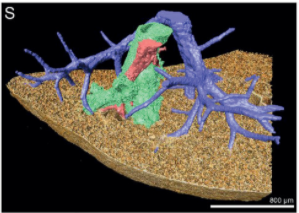Multiscale Co‐reconstruction of Lung Architectures and Inhalable Materials Spatial Distribution
Pulmonary diseases, such as chronic obstructive pulmonary diseases, lower respiratory infections, and lung cancer are listed in the top ten causes of deaths globally with more than 10 million mortality per year. Apart from oral administration, the Dry Powder Inhalation (DPI) for pulmonary administration provides an important alternative route for targeted treatment of these pulmonary diseases. […] Furthermore, there is a growing demand on understanding the thorough lung architectures, as well as, the accurate distribution patterns in vivo and deposition mechanisms of the inhaled materials at 3D, in situ, and single‐particle level. Thus, a novel strategy that reveals the spatial distribution of inhaled particles precisely at multi‐scale ranging from sub‐micron to the whole lung scale needs to be established.

The effective pulmonary deposition of inhaled particulate carriers loaded with drugs is a prerequisite for therapeutic effects of drug delivery via inhalation route. Revealing the sophisticated lung scaffold and intrapulmonary distribution of particles at three‐dimensional (3D), in‐situ, and single‐particle level remains a fundamental and critical challenge for dry powder inhalation in pre‐clinical research. […] Overall, this research delivers comprehensive and high‐resolution 3D detection of pulmonary drug delivery vectors and provides a novel strategy to evaluate materials distribution for drug delivery.